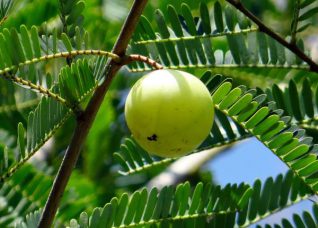
MinerAlert

MinerAlert
Phyllanthus emblica
Phyllanthaceae
amla, aamlaa, aamalaki, dhataari, emblic myrobalan, Indian Gooseberry, yu gan zi (Quattrocchi, 2012; Mabberley, 2008; Torkelson,1999).
Grosella Espinosa de la India, Emblica

This small tree is native to tropical and subtropical Asia (Quattrocchi, 2012; Mabberley, 2008).
The leaves, bark, flowers, fruit, and seeds.
Currently, tablets and capsules containing Dan shen root, alone or in combination with other herbs, are available in commerce.
The flowers have a cooling action. The pounded leaves are used against vomiting (antiemetic). A paste made from the leaves is applied topically for wounds; the leaf juice is taken internally for scorpion stings and diarrhea. The fresh fruit promotes urinary flow (diuretic). The fruit is taken as a “blood purifier”, an astringent, laxative, and tonic. The fruit is boiled in water and combined with sugar for spermatorrhea (involuntary seminal emissions). A decoction of the bark is taken as a tea for dysentery. The seeds, roots, and leaves are taken for high blood pressure, for coughs, as well as for blood disorders. The bark is also used as a fish poison (Quattrocchi, 2012; Khare 2016, 2004).
The fruit is edible and has both curative as well as nutritional properties (Majeed et al, 2009; Sivarajan and Balanchandran 1994).The fruit is edible and nutritious, having a high content of vitamin C; approximately two to three times that of oranges. However, the antioxidant capacity of an Emblica extract has shown to be superior to that of ascorbic acid itself (Khare, 2016; Majeed et al., 2009).
Emblica, along with two other plant species, is part of an Ayurvedic composite remedy called “Triphala”. This remedy is part of a rejuvenation therapy called rasayana (Khare, 2016).
A study was undertaken in non-obese type 2 diabetic rats to assess the potential anti-diabetic activities of Emblica via its main active ingredient, ellagic acid (EA), both in vitro, as well as in vivo. the rats were treated with an Emblica methanolic extract (250 or 500 mg/kg) for 28 days, and various parameters (blood glucose, serum insulin, and plasma antioxidant status) were measured. The results of the study demonstrated that the rats treated with the Emblica extract showed a significant decrease in the fasting blood glucose in a dose and time-dependent manner. Additionally, the plant extract significantly augmented serum insulin levels in the diabetic rats in a dose-dependent manner. The authors concluded that EA present in the Emblica extracts exerted an anti-diabetic effect via the action on pancreatic β cells that stimulated insulin secretion and diminished glucose intolerance (Fatima et al., 2015).
Emblica fruit contains natural antioxidants including gallic acid, gallotanin, ellagic acid and corilagin, among others, which have antioxidant and free radical scavenging properties. The plant has been shown to have hypoglycemic (anti-diabetic) effects, as well as to protect against cardiac complications, diabetic nephropathy, neuropathy, and cataracts (D’Souza et al., 2014).
Clinical studies with Emblica have shown that it increases production of nitric oxide, glutathione, and high-density lipoprotein (HDL) or “good cholesterol”. Additionally, it may decrease low-density lipoprotein (LDL) or “bad cholesterol”, total cholesterol, triglycerides, and high-sensitivity C-reactive protein (hsCRP) - a marker for inflammation. Emblica can also significantly inhibit platelet aggregation. A study was undertaken to assess if a treatment with Emblica could have benefit on myocardial ischemia-reperfusion injury. The results showed that the plant has a cardio-protective effect, thereby preserving heart tissue during ischemia-reperfusion injury (Thirunavukkarasu et al. 2015).
Various in vivo and in vitro studies indicate that Emblica fruit extracts have powerful anticancer properties via their content of natural antioxidant polyphenolic compounds, principally tannins and flavonoids (Zhao et al., 2015).
A study found that Emblica fruit exerts its anticancer effects by inhibiting a transcription factor (AP-1) as well as interfering with the transcription and expression of viral oncogenes, which are responsible for the development, as well as the progression of cervical cancer. For this reason, the authors concluded that the fruit might have potential uses for treatment of human papilloma virus (HPV) induced cervical cancers (Mahata et al., 2013).
Safety/Precautions:
Before you decide to take any medicinal herb or herbal supplement, be sure to consult with your health care professional first. Avoid self-diagnosis and self-medication: Always be on the safe side!